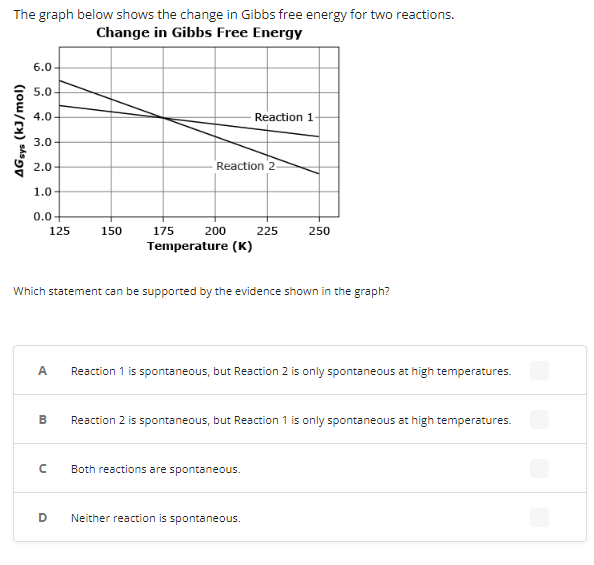The graph below shows the change in Gibbs free energy for two reactions. Change in Gibbs Free Energy 6.0- 5.0 4.0- Reaction 1- 3.0 2.0 Reaction 2 1.0 0.0 200 Temperature (K) 125 150 175 225 250 Which statement can be supported by the evidence shown in the graph? A Reaction 1 is spontaneous, but Reaction 2 is only spontaneous at high temperatures. B Reaction 2 is spontaneous, but Reaction 1 is only spontaneous at high temperatures. Both reactions are spontaneous. Neither reaction is spontaneous. AGsys (kJ/mol) D.
The graph below shows the change in Gibbs free energy for two reactions. Change in Gibbs Free Energy 6.0- 5.0 4.0- Reaction 1- 3.0 2.0 Reaction 2 1.0 0.0 200 Temperature (K) 125 150 175 225 250 Which statement can be supported by the evidence shown in the graph? A Reaction 1 is spontaneous, but Reaction 2 is only spontaneous at high temperatures. B Reaction 2 is spontaneous, but Reaction 1 is only spontaneous at high temperatures. Both reactions are spontaneous. Neither reaction is spontaneous. AGsys (kJ/mol) D.
General Chemistry - Standalone book (MindTap Course List)
11th Edition
ISBN:9781305580343
Author:Steven D. Gammon, Ebbing, Darrell Ebbing, Steven D., Darrell; Gammon, Darrell Ebbing; Steven D. Gammon, Darrell D.; Gammon, Ebbing; Steven D. Gammon; Darrell
Publisher:Steven D. Gammon, Ebbing, Darrell Ebbing, Steven D., Darrell; Gammon, Darrell Ebbing; Steven D. Gammon, Darrell D.; Gammon, Ebbing; Steven D. Gammon; Darrell
Chapter18: Thermodynamics And Equilibrium
Section: Chapter Questions
Problem 18.121QP
Related questions
Question

Transcribed Image Text:The graph below shows the change in Gibbs free energy for two reactions.
Change in Gibbs Free Energy
6.0-
5.0-
4.0-
Reaction 1-
3.0
2.0
Reaction 2
1.0
0.0-
125
150
175
200
225
250
Temperature (K)
Which statement can be supported by the evidence shown in the graph?
A
Reaction 1 is spontaneous, but Reaction 2 is only spontaneous at high temperatures.
B
Reaction 2 is spontaneous, but Reaction 1 is only spontaneous at high temperatures.
Both reactions are spontaneous.
D.
Neither reaction is spontaneous.
AGsys (kJ/mol)
Expert Solution
This question has been solved!
Explore an expertly crafted, step-by-step solution for a thorough understanding of key concepts.
This is a popular solution!
Trending now
This is a popular solution!
Step by step
Solved in 2 steps with 1 images

Knowledge Booster
Learn more about
Need a deep-dive on the concept behind this application? Look no further. Learn more about this topic, chemistry and related others by exploring similar questions and additional content below.Recommended textbooks for you

General Chemistry - Standalone book (MindTap Cour…
Chemistry
ISBN:
9781305580343
Author:
Steven D. Gammon, Ebbing, Darrell Ebbing, Steven D., Darrell; Gammon, Darrell Ebbing; Steven D. Gammon, Darrell D.; Gammon, Ebbing; Steven D. Gammon; Darrell
Publisher:
Cengage Learning

Chemistry: An Atoms First Approach
Chemistry
ISBN:
9781305079243
Author:
Steven S. Zumdahl, Susan A. Zumdahl
Publisher:
Cengage Learning

Chemistry
Chemistry
ISBN:
9781305957404
Author:
Steven S. Zumdahl, Susan A. Zumdahl, Donald J. DeCoste
Publisher:
Cengage Learning

General Chemistry - Standalone book (MindTap Cour…
Chemistry
ISBN:
9781305580343
Author:
Steven D. Gammon, Ebbing, Darrell Ebbing, Steven D., Darrell; Gammon, Darrell Ebbing; Steven D. Gammon, Darrell D.; Gammon, Ebbing; Steven D. Gammon; Darrell
Publisher:
Cengage Learning

Chemistry: An Atoms First Approach
Chemistry
ISBN:
9781305079243
Author:
Steven S. Zumdahl, Susan A. Zumdahl
Publisher:
Cengage Learning

Chemistry
Chemistry
ISBN:
9781305957404
Author:
Steven S. Zumdahl, Susan A. Zumdahl, Donald J. DeCoste
Publisher:
Cengage Learning


Chemistry: Principles and Practice
Chemistry
ISBN:
9780534420123
Author:
Daniel L. Reger, Scott R. Goode, David W. Ball, Edward Mercer
Publisher:
Cengage Learning

Principles of Modern Chemistry
Chemistry
ISBN:
9781305079113
Author:
David W. Oxtoby, H. Pat Gillis, Laurie J. Butler
Publisher:
Cengage Learning